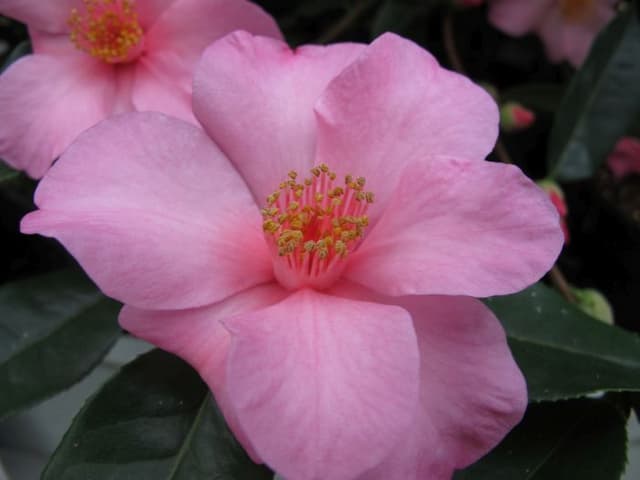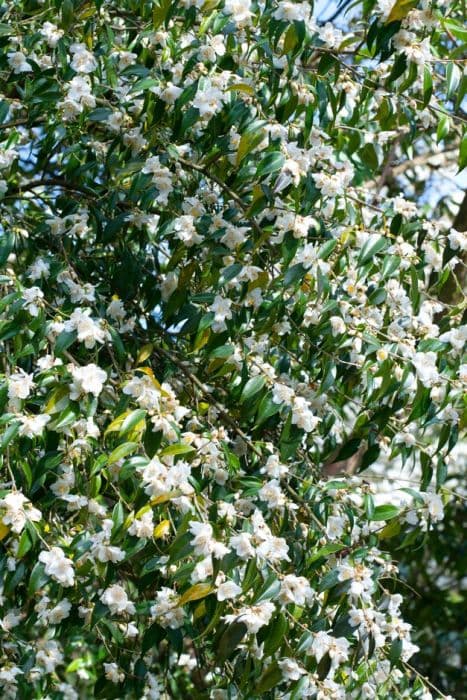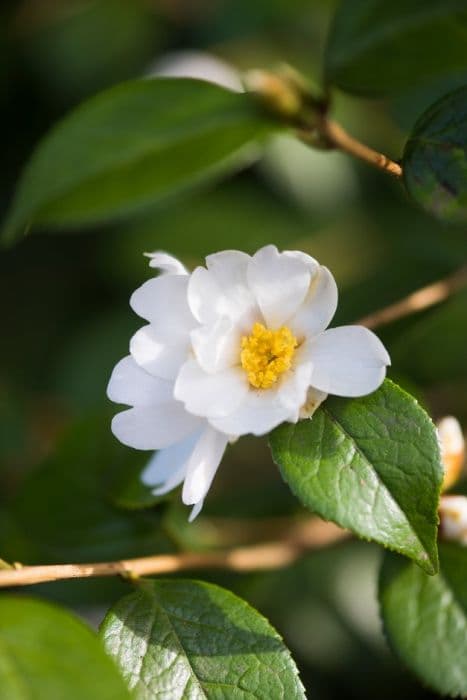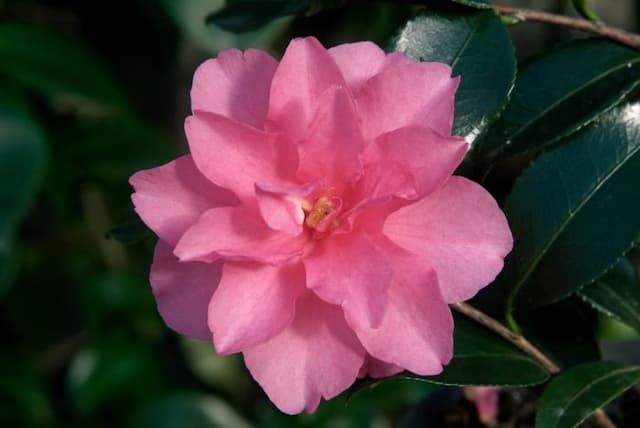Japanese Camellia Camellia japonica 'Commander Mulroy'

ABOUT
The Camellia japonica 'Commander Mulroy' is an ornamental plant known for its lush, glossy, dark green leaves that offer a striking backdrop to its prominent flowers. The blooms are typically large, with numerous petals that exhibit a luxurious, velvety texture. The color of the flowers can be a deep red to pink, often with a luminous quality that stands out against the foliage. Each flower has a symmetrical form and may bear a resemblance to roses, featuring a layered arrangement of petals that can either be loosened or tightly packed, depending on the particular variety. The flowers make a dramatic statement when they are in full bloom, creating a visual display that can be a focal point in any garden setting. This plant is known for its glossy and leathery leaves which often have a slightly serrated edge, providing a year-round interest even when the plant is not flowering. It is a favored choice for gardeners looking to add a touch of elegance to their landscape with a plant that has both stunning foliage and show-stopping blooms.
About this plant
 Names
NamesFamily
Theaceae.
Synonyms
Japanese Camellia, Rose of Winter.
Common names
Camellia japonica 'Commander Mulroy'.
 Toxicity
ToxicityTo humans
Camellia japonica, commonly known as Japanese camellia, is not considered toxic to humans. There are no well-documented cases of poisoning from ingesting this plant, and it is generally regarded as safe. However, as with any non-food plant, ingesting plant parts in large quantities could potentially cause stomach upset or discomfort due to the presence of natural plant compounds not meant for human consumption.
To pets
Japanese camellia is not known to be toxic to pets. It is not listed among the common poisonous plants for cats and dogs. While the ingestion of large amounts of plant material may cause mild digestive upset in some pets, such as vomiting or diarrhea, significant toxicity is not expected. It is still advisable to prevent pets from eating plants, as individual animals may have different sensitivities or allergies.
 Characteristics
CharacteristicsLife cycle
Perennials
Foliage type
Evergreen
Color of leaves
Green
Flower color
Pink
Height
6-10 feet (1.8-3.0 meters)
Spread
5-7 feet (1.5-2.1 meters)
Plant type
Shrub
Hardiness zones
7
Native area
Japan
Benefits
 General Benefits
General Benefits- Ornamental appeal: Camellia japonica 'Commander Mulroy' is renowned for its striking flowers, often used to enhance garden aesthetics.
- Year-round interest: The plant offers glossy, evergreen foliage that provides visual interest even when it is not in bloom.
- Shade tolerance: This camellia variety can thrive in partially shaded areas where other flowering plants may struggle.
- Drought resistance: Once established, the plant is fairly resistant to drought, reducing the need for frequent watering.
- Low maintenance: It requires minimal pruning and care once established, making it a convenient choice for gardeners.
- Wildlife habitat: The dense foliage can serve as a shelter for birds and beneficial insects.
 Medical Properties
Medical PropertiesThis plant is not used for medical purposes.
 Air-purifying Qualities
Air-purifying QualitiesThis plant is not specifically known for air purifying qualities.
 Other Uses
Other Uses- Camellia japonica leaves can be used for artistic purposes; pressing the leaves in books can preserve them for collages or other creative projects.
- The petals of Camellia japonica can be used as a natural dye for fabrics, producing a range of colors from pink to brown, depending on the mordant used.
- Wood from the Camellia japonica can be fashioned into small woodworking projects like handles for tools or cutlery, as it is hard and durable.
- The flowers of Camellia japonica can be used to make floral jelly, imparting a subtle flavor and aroma, though this is not commonly done.
- Dried Camellia japonica flowers can create decorative inlays in woodworking, adding a unique floral element to furniture or art pieces.
- Camellia japonica can be used for bonsai purposes due to its ability to adapt to pruning and shaping.
- The thick foliage of Camellia japonica makes it suitable for creating privacy screens or hedges in landscaping.
- The fallen petals of Camellia japonica can be collected and used as a natural, decorative mulch in garden beds.
- Camellia japonica can serve as an educational tool in horticultural classes, exemplifying plant propagation techniques such as grafting or air layering.
- Used ceremonially, Camellia japonica can be included in floral arrangements for special events and cultural celebrations due to their beauty and significance in various cultures.
Interesting Facts
 Feng Shui
Feng ShuiCamellias are not commonly addressed in Feng Shui practice.
 Zodiac Sign Compitability
Zodiac Sign CompitabilityCamellias are not used in astrology practice.
 Plant Symbolism
Plant Symbolism- Desire or Passion: The vibrant blooms of the Camellia signify deep desire and yearning, often used to express feelings of romantic passion.
- Affection: Gifting someone Camellia flowers implies admiration and profound affection, suggesting the giver's genuine fondness for the receiver.
- Perfection and Excellence: Due to its perfectly formed petals and elegant appearance, the Camellia symbolizes the pursuit of perfection and excellence.
- Long-lasting Devotion: Camellias are known for their longevity and this trait symbolizes the enduring nature of love, indicating a commitment that stands the test of time.
- Admiration: The Camellia can express admiration for someone's qualities and is often given as a sign of respect or esteem.
- Good Fortune: In some cultures, Camellias are seen as a harbinger of good luck and are often used in celebrations to wish prosperity and good fortune.
 Water
WaterThe Japanese camellia, known as 'Commander Mulroy,' should be watered deeply to ensure that the root zone is thoroughly moistened, generally requiring about 1 to 1.5 gallons of water weekly during the growing season. The frequency of watering may need to be increased during prolonged periods of dry weather or if the camellia is planted in well-draining soil that dries out quickly; however, it's important not to overwater, as camellias are sensitive to soggy conditions. Ensure the soil surface is slightly dry to the touch before adding water again. During the winter, reduce watering to every two to three weeks, providing enough water to prevent the soil from completely drying out. In any case, avoid light, frequent waterings, which do not encourage deep root growth and can promote root diseases.
 Light
LightJapanese camellias like 'Commander Mulroy' thrive best in partial shade or filtered sunlight. They should be planted in a spot sheltered from direct afternoon sunlight, which can be too harsh and lead to leaf scorch. An ideal location is under tall trees that provide dappled sunlight or on the north or east side of a building, where they can receive bright morning light and protection from intense afternoon rays.
 Temperature
TemperatureJapanese camellias such as 'Commander Mulroy' prefer temperate conditions and can generally withstand temperatures as low as 20 to 30 degrees Fahrenheit but may suffer damage if temperatures drop below this range. The ideal temperature for promoting lush growth and bloom ranges from 60 to 70 degrees Fahrenheit. They can tolerate short periods of higher temperatures but require adequate moisture and shade to endure hot summers.
 Pruning
PruningPrune Japanese camellias like 'Commander Mulroy' to shape the plant, remove dead or weak growth, and promote airflow, which prevents disease. The best time for pruning is just after flowering ends, typically in late winter or early spring. Prune sparingly, as camellias can take several years to recover from heavy pruning, and focus on thinning out crowded branches rather than cutting back the entire plant. Annual, light pruning is sufficient to keep the plant looking tidy and healthy.
 Cleaning
CleaningAs needed
 Soil
SoilThe Japanese Camellia 'Commander Mulroy' prefers well-draining, acidic soil with a pH between 5.5 and 6.5. An ideal soil mix would consist of equal parts pine bark, peat moss, and perlite, ensuring good aeration and moisture retention. Regularly test soil pH to maintain acidic conditions for optimal growth.
 Repotting
RepottingThe Japanese Camellia 'Commander Mulroy' should be repotted every 2 to 3 years to refresh the soil and promote healthy growth. It's best to repot in the spring after flowering but before new growth begins, using soil with the same acidic pH conditions.
 Humidity & Misting
Humidity & MistingJapanese Camellia 'Commander Mulroy' thrives in moderate to high humidity levels, ideally between 50% to 80%. Consistent humidity fosters lush growth and vibrant blooms while helping to prevent bud drop.
 Suitable locations
Suitable locationsIndoor
Provide bright, indirect light and keep soil moist.
Outdoor
Plant in partial shade with shelter from strong winds.
Hardiness zone
7-9 USDA
 Life cycle
Life cycleCamellia japonica 'Commander Mulroy', commonly known as the Japanese Camellia, begins its life as a seed that germinates in moist, well-draining soil, usually in early spring. The seedling then develops into a young plant with a set of true leaves, and as it matures, it forms a bushy evergreen shrub with glossy, dark green leaves. Throughout late winter to early spring, the plant enters its reproductive stage, flowering with large, showy blossoms, typically red to deep pink in color. After pollination, the blooms give way to seed capsules that ripen in fall, releasing seeds to give rise to new plants and continuing the cycle. Over time, the Japanese Camellia can develop into a substantial shrub or small tree, needing regular pruning to maintain its shape and encourage more prolific blooming. With proper care, this camellia can live for many years, even decades, as it gradually grows and goes through its annual cycle of growth, flowering, and seed production.
 Propogation
PropogationPropogation time
Early Spring
Camellia japonica 'Commander Mulroy', commonly known as the Japanese camellia, is most effectively propagated by semi-hardwood cuttings. This method typically begins in late summer when the new growth has begun to harden. A cutting should be taken from a healthy branch, measuring about 4 to 6 inches (10 to 15 centimeters) in length. Leaves are removed from the lower half of the cutting to expose the nodes where roots will develop. The cutting end is often dipped in rooting hormone to encourage root growth and then inserted into a well-draining soil mix. A plastic bag or a dome is sometimes placed over the cutting to maintain high humidity. The cutting should be kept in a warm, bright spot out of direct sunlight, and in a few weeks to months, it should develop roots and can be transplanted. This method is favored due to its simplicity and decent success rate.









